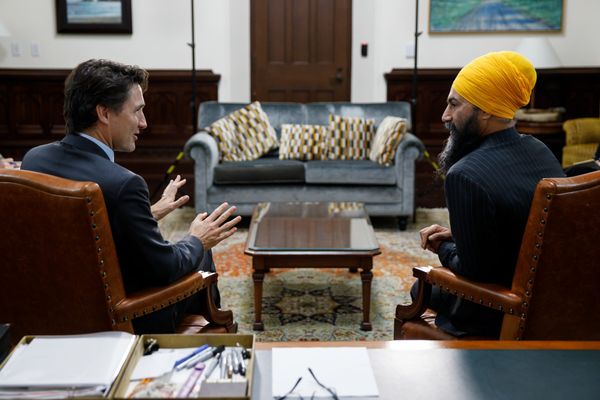Canadians are facing an unemployment crisis. As of early June, the official unemployment rate was 13.7 per cent, the worst since the Great Depression. While the partial reopening of the economy later that month created 953,000 new jobs, the unemployment rate still stands at 12.3 per cent, an indication of the severity and likely long duration of the crisis.
The realistic rate of unemployment in April — a more inclusive measure that counts people who technically still have a job but aren’t working, people who lost most of their hours and people who want to work but have stopped looking for scarce jobs — was 33.5 per cent. Perhaps never before has our policy and discourse about unemployment been more consequential.
Unemployment is a problem, and not just in times of crisis. But unfortunately, not everyone agrees. While workers experience unemployment as immiseration, and benefit when unemployment rates are low, financial and business interests have reason to prefer high unemployment, and sometimes cultivate it for the sake of profits. Unemployment, in other words, is a matter of class struggle.
Looking at unemployment throughout Canadian history highlights the conflict between workers’ interests and those of business and finance, as well as the role of the state in deflecting, managing and sometimes acceding to popular demands. This history of unemployment in Canada suggests that in rebuilding the economy after the virus, we’ll need to put workers first.
Class Dynamics of Unemployment
Workers are better off when there are low unemployment rates and good benefits. With low unemployment rates, workers find jobs more easily, while good benefits reduce the impact of lost wages between jobs. Secure and confident workers also end up pressuring employers for better wages and conditions, since they can risk losing a job without worrying about their fate.
For business, however, it’s another story. High unemployment rates mean employers can take their pick of the glut of applicants, offering them lower wages. Poor unemployment benefits make workers more desperate to take a job, and to keep the one they have. And frightened and vulnerable workers provide weak resistance to management’s demands to intensify their workload.
Inflation also relates to unemployment, revealing class interests. According to the recent orthodoxy guiding central banks, high unemployment rates keep spending (i.e. demand) low, thereby keeping inflation low. Low inflation is particularly good for banks and investors, since high inflation erodes the real value of their return on investments and loans. Indeed, protecting investors and bankers through low inflation has been a policy priority for the last 40 years, at the cost of workers’ employment and wages.
Unemployment in Neoclassical Economics
In the late-19th and early 20th centuries, the capitalist economy, like today, was fraught with booms and busts that frequently threw people out of work. In the face of such obvious failures, neoclassical economists such as Léon Walras developed abstract theories to prove the efficacy and morality of capitalist markets. The self-regulating markets, they claimed, would naturally settle at full employment, using all available labour.
According to this supply-side theory, it was inputs, labour among them, that constrained production. With balanced markets, there was no involuntary unemployment, only workers who were unwilling to accept the prevailing wage. Perversely, workers could be blamed for the fact that jobs didn’t exist.
Neoclassical theory was willfully blind to power imbalances between workers and bosses, but not surprisingly, these ideas appealed to capitalists. Neoclassical ideas discredited attempts to regulate labour markets with minimum wage and other workplace laws, as any intervention would supposedly disrupt the elusive equilibrium.
The theory justified paying workers as little as the market allowed — in reality, as little as employers could impose — and provided moral cover for employers, with the state’s help, to crack down on strikes and unionization efforts on the grounds that they disrupted the natural functioning of labour markets.
Unemployment During the Great Depression
The Great Depression of the 1930s strained credulity in laissez-faire, neoclassical explanations. Unemployment reached 30 per cent in 1933, putting millions of Canadians out of work. Strikes, demonstrations and riots grew in frequency, aggravated by violent state repression, such as the RCMP killing three coal miners at a strike in Estevan, Sask., in 1931. While neoclassical truisms proved tenacious, amid the mass upheavals unemployment could not be credibly explained as a choice by workers not to work.
On his way to the Prime Minister’s Office in 1930, Conservative Party leader R.B. Bennett appealed to voters by adopting a different rhetoric around unemployment. “Someone is responsible for unemployment,” Bennett said on the campaign trail, “not individuals, but governments.”
Although Bennett experimented with government labour camps and increased relief transfers, he quickly retreated to neoclassical principles, cutting pay to labourers and then reducing transfers, blaming easy money for eroding Canadians’ work ethic.
The Communist Party, the Co-operative Commonwealth Federation (CCF) and other left-wing organizations voiced popular demands for jobs and unemployment benefits. In contrast with the neoclassical supply-side theories, British economist John Maynard Keynes, in his 1936 text General Theory, wrote, “The government should pay people to dig holes in the ground and then fill them up.” The point was that putting more money in workers’ hands would stimulate demand in the market.
Keynesianism, however, had little impact in Canada during the Depression. Liberal Prime Minister Mackenzie King, elected to office again in 1935, waited for things to improve on their own. He created a federal unemployment benefit in 1940, only when war spending had already restored high levels of employment.
Managing Unemployment Through Post War Keynesianism
After the war, fearing a return to Depression conditions, the government recognized new responsibilities for management of the economy, including unemployment. The 1945 White Paper — presented to parliament by C.D. Howe, the businessman who had managed the Canadian war economy — outlined a conservative Keynesianism, committing the government to pursuing “a high and stable level of employment and income.”
When unemployment rates rose, the government invested, spurring job creation. While the CCF criticized the Liberals and Conservatives for spending public dollars to foster private enterprise, the postwar government also made major investments in public infrastructure, health and education, which vastly expanded employment in the public sector.
This was the time of a wary compromise between labour and capital. Buoyed by generally low unemployment, as well as strong unions and benefits, workers saw regular pay increases and growing spending power. Meanwhile, business, constrained by political necessity, conceded wage and tax demands, which they could afford with their high profits, fuelled partly by increased consumption.
In addition to managing unemployment levels through investment, the government slowly increased its commitments to unemployment insurance. A rise in unemployment rates after the end of the Korean War sparked public pressure on the Liberal government to pass a 1954 reform expanding unemployment insurance coverage to 59 per cent of workers, an increase from the 42 per cent originally covered.
The upwelling of democratic mobilization in the late 60s and early 70s showed that many Canadians believed they had a right to jobs and social benefits. These movements pressured the government for further reforms to unemployment insurance in 1971, after which 96 per cent of workers were covered, and benefits were nearly doubled, from a maximum of $53 to $100 a week.
Neoliberalism’s Attack on Workers
By the 70s, business faced falling profitability due to global competition and overproduction as well as an unruly and demanding labour force. In 1976, for example, 1.5 million Canadians went out on strike for more than 11.6 million person days. The mid-70s marked the beginning of neoliberal reforms — in many ways a return to neoclassical economics — with severe consequences for workers.
Inflation was the metric shaping public policy and discourse. As writer Doug Henwood explains, the high inflation rates can be understood as a result of the stalemate between labour and capital in the postwar era, as business raised prices to recapture profit lost to labour in wages, creating a wage-price spiral. But inflation has many causes, and it only reached crisis levels after OPEC (Organization of the Petroleum Exporting Countries) drove up oil prices in 1973 from $4 a barrel to $10, and then again in 1979, from $15 to $30.
Yet elites and the media tended to blame workers for inflation, castigating them for their supposed greed in seeking better pay. Prime Minister Pierre Trudeau himself attempted to ideologically reorient Canadians. Speaking in 1975 about wage controls, Trudeau said, “In this struggle, we must accomplish nothing less than a wrenching adjustment of our expectations — an adjustment of our national lifestyle to our means.” In the intensifying class struggle, the government signaled it wouldn’t be taking the side of workers.
The neoliberal economists, epitomized by Milton Friedman, convinced heads of state and policy makers to begin a dramatic retooling of the economy. After wage controls failed to stop inflation (although they dramatically curbed wages), Trudeau pursued monetary policy, following the United States Federal Reserve of Paul Volcker.
The Canadian Department of Finance, in a cabinet document, recognized that higher unemployment would reduce the bargaining power and militancy of workers, thereby driving down wages and eventually inflation. In 1981, interest rates were raised above 20 per cent, slowing investment and resulting in a deep recession. Unemployment jumped to 11 per cent in 1982, the highest since the Great Depression at the time.
With high unemployment and a hostile government, workers lost confidence. Strikes declined and real wages fell. A famous chart of the American economy shows the divergence between rising productivity and lagging real wages beginning in 1973. In Canada, by 2017 the average hourly wage remained almost unchanged in 40 years, with the minimum wage, relative to the cost of living, having peaked in 1976.
Just as greedy workers were blamed for the inflation crisis, the unemployed were vilified as “welfare bums.” Negative characterizations of the jobless helped justify rolling back unemployment insurance. Benefits and eligibility for the renamed “employment insurance” were restricted by both the Brian Mulroney and the Jean Chrétien governments in turn. By 1997, only 41 per cent of the unemployed were eligible for EI, less than when the program was introduced in 1940.
Since the 2008 Crash
The crash of 2008 both revealed the weakness of the neoliberal economy and intensified its impacts on workers. Well after growth returned to markets in 2009, buoyed by the quantitative easing and cheap credit of central banks, job creation remained sluggish. In Canada, unemployment rates remained above 2007 levels for more than a decade.
With a decade of high unemployment, capital took further advantage of the vulnerability of workers to erode job quality and security. New technologies, combined with lax labour laws, allow for intensified monitoring and just-in-time production. These management regimes inflict workers with endemic underemployment and precarity not even captured in headline unemployment rates.
‘Welfare bum’ discourses were updated to a new era, too, with millennials now responsible in the eyes of media and business elites for their low wages and prospects.
What Now?
As further waves of COVID-19 hit, high unemployment will likely persist. Still more people will be thrown out of work if small businesses with already slim margins, and zombie companies who can’t cover debt servicing, fail. In the 30s and the early 80s, the unemployment crisis marked epochal shifts in our economy. Perhaps another major change is inevitable. But what should we expect, and what can we do?
With high unemployment, those who still have jobs should expect attacks on their wages and working conditions. As usual, it’s workers in the lowest paid sectors who are hit first and worst. Loblaw’s has already rolled back a $2 per hour wage increase despite their increased profits. Meanwhile, Alberta premier Jason Kenney has laid off thousands of public-sector workers and seems to be contemplating a cut to the minimum wage, following his $2 per hour reduction to the youth minimum wage last year.
While it’s easier said than done, workers and their unions should resist every attempt to cut wages or worsen work conditions. Polling from both the U.S. and Canada about recent labour conflicts shows public support for unions and striking workers. With many facing tough times, workers may be able to cultivate sympathy and build solidarity with each other. Likewise, we should refute any attempt to villainize the unemployed and those receiving benefits.
This blame game has already begun, with op-eds making unfounded claims of Canada Emergency Response Benefit (CERB) fraud, and businesses griping about employees’ reluctance to risk deadly infection at the workplace for paltry pay. The Liberal government itself proposed a failed bill — opposed by the NDP — to criminalize so-called CERB fraud, a tactic meant to scare employees back into the bosses’ clutches.
As Toronto Star contributing columnist Jim Stanford writes, even in late-2019 the Canadian low-wage sector had more than 149,000 unfilled vacancies. This is due in large part to the poor wages and working conditions on offer. Rather than cutting benefits in a race with these bad employers to the bottom, government should provide more generous and universal income supports, forcing businesses to improve their offers.
The strongest factor affecting unemployment is investment, but private investment will be even weaker with current uncertainty. Instead, the public sector will have to do the investing. Green energy, transit, infrastructure, healthcare, education, arts and culture — there’s no lack of work to be done, and no shortage of workers. It’s time to pursue a full employment policy, which could be funded by a public works bank.
If we want to rebuild our economy, it’s time to prioritize workers, employed and unemployed alike.






